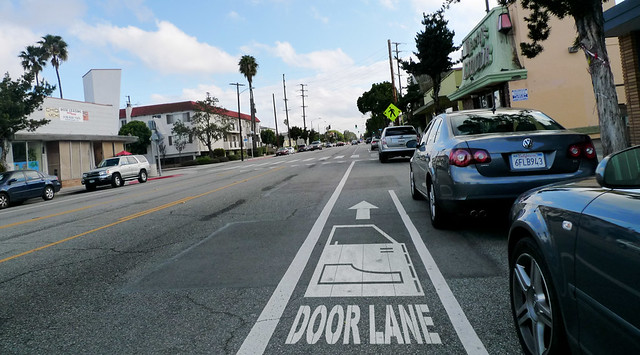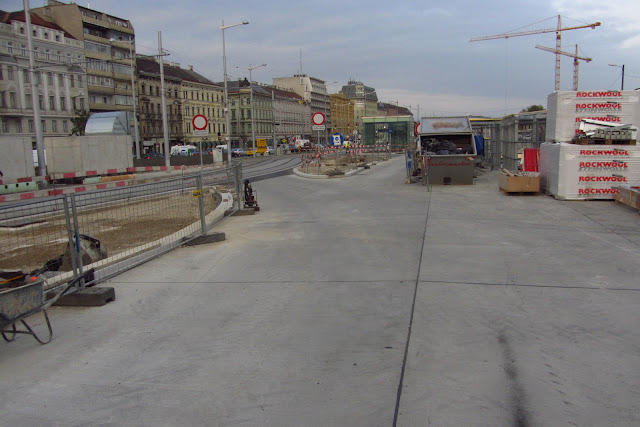I was very happy to get a reply but the reply basically said the Door Zone was not a problem (it is), I am breaking the law if I try to protect myself by riding out of the door zone of death (debatable but I would rather be fined than seriously injured), cycle paths are dangerous (only if designed poorly) and this paint on solution is the result of 10 years work so do not expect change soon (10 years!). There is too much in the response to get really angry about in just one blog post so this is maybe part 2 of a series... However there was one fair point in the reply that stated my proposal to paint car doors in the Door Zone lane and not bikes was cynical and not constructive.
Despite being not the only person to get really frustrated with such terrible cycling infrastructure. I shall try to be constructive.
The problem with Landstrasse from a cycle traffic perspective is that it is a District Access Road which are very difficult roads to get right. These types of roads have many functions and a clear strategy is not always obvious.
Here is a typical problem section of Landstraße Hauptstraße. There is Parking both sides narrow Mehrzweckstreifen and busy footpaths. These Parking bays are short term so that means the car doors open a lot. There are also many cars performing parking manoeuvres reversing into spaces and blocking bike and motor traffic. There are many small trucks and vans delivering goods to the many shops and the local market. There is excellent public transport on this street with the U3 Underground running underneath and buses along the road. At the North end of the Street is the new Wien Mitte railway station.
The road plan looks like this:
I think this road has a 50kmph speed limit but the road is so busy that it is hard to drive very fast. Average speed for cars (despite some efforts to drive at well over 50kmph) is about the same as fast bikes here except in rush hour when it is a lot slower. I cope with this road by riding very fast and aggressively but this is not pleasant, safe or something normal people will want to adopt as a daily routine. So the first obvious thing to do would be to lower the speed limit to 30kmph. This would greatly reduce the conflict with bikes and increase the safety of the many pedestrians without really affecting the average speed of motor traffic.
This is also one of the main routes for district traffic. Motor traffic reduction is the next obvious thing to do to make this a more pleasant shopping street. This would maybe involve a one way system and modifying the surrounding streets.
There are many pedestrians and so the footpaths should not be any smaller. This is the main high street for the 3rd district and should be a nice place for people, with cafes, market and shops so the pedestrians should not lose space.
So how do you do a cater for bike traffic, pedestrians, 2 way 50kmph motor traffic and parking, on a shopping high street? What would the Dutch Do?
You can have a separated 2 way bike lane protected with bollards to stop it being used as a unloading/parking lane. This would reduce parking capacity although the other side of the road could become diagonal parking bays. It creates a clear protected cycle path without door zone or taking space from pedestrians, However Junctions would be complex and very difficult. This option is a compromise that could work but it means all road users would have to compromise a bit.
The parking could be removed completely and one way cycle lanes put in. This would maintain the motor traffic capacity and allow the foot path to be made wider in some places and reduced in others. It would make junction easier to design but Bus stops and loading bays are very problematical.
You could squeeze the cycle paths to the pedestrian side of the car parking. This reduces dooring problems because most cars only have one occupant (the driver) who opens the door on the motor traffic side (so they probably look first because suddenly they are the vulnerable road user). If a cyclist hits a passenger side car door they get thrown in front of pedestrians instead of 50kmph motor traffic, so serious injury is very possible but death is unlikely.
I can only conclude that separate cycle paths on this road are only possible with the reduction of parking, and even then they are not ideal. I think a solution can only be a complex mix of dramatic traffic reduction, 30kmph speed limit, enforced with traffic calming structures and environment, parking space reduction and few loading bays for deliveries. If this is done well then cycling along this road would be much more pleasant and this would be a step towards nice road to shop and be on.
So to answer my questions:
Q: How do you do a compromise and cater for bike traffic, pedestrians, 2 way 50kmph motor traffic and parking on a shopping street?
A: You can not.
Q: How would the Dutch compromise and cater for bike traffic, pedestrians, 2 way 50kmph motor traffic and parking on a shopping street?
A: They would not. A shopping street is for shopping.
A quick Google search for shopping streets and StreetView yields:
The city of Vienna has a similar road design disaster problem with the biggest shopping street in Vienna Mariahilferstrasse. This street is so busy that it has to close to motor traffic every December due to the number of Christmas shopping pedestrians that can not fit on the footpaths. Next year it will finally be changed from a bidirectional main road with door zone cycle infrastrucutre and parking on boths sides to a proper shopping street so maybe there is hope. Does Landstraße Hauptstraße have to wait for the situation to get so bad that 4 lanes of motor traffic space are reduced to zero, will this street become even more dis-functional as everyone takes the U3 a few stops to Mariahilfe to do their shopping, or do the local politicians have the courage to realize that they are there to represent local people and businesses not motor cars?











































